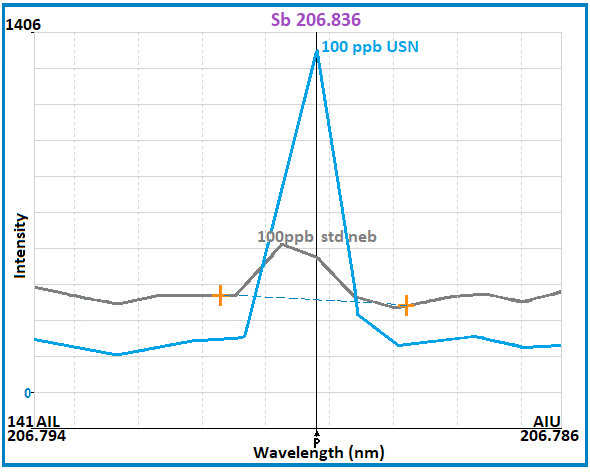Performance
The U5000AT+ converts more sample into useable aerosol, with an efficiency of 10–15% versus 2–3% for conventional pneumatic nebulizers. The result is up to 10x improvement in analyte signal and detection limits. For example, Figure 1 depicts an approximate 8× enhancement in signal for antimony (Sb) using the U5000AT+ with ICP-OES detection. For ICP-OES detection, limits fall below 1µg/L for many elements. For ICP-MS sub-ng/L limits can be achieved; even lower limits may be obtained under clean-room conditions. Short term (60 minute) and long-term (8 hour) stability is excellent, with %RSDs typically < 1%.
Fast and Easy Setup
Each U5000AT+ comes with an interface kit for easy connection to the host ICP-OES or ICP-MS. Setup can be completed in about 5 minutes.
 Figure 1. Comparison of signal intensities for 100 µg/L Sb using standard pneumatic nebulizer and U5000AT+ USN
Figure 1. Comparison of signal intensities for 100 µg/L Sb using standard pneumatic nebulizer and U5000AT+ USN
Convenient Features
The U5000AT+ has a compact footprint for placement on a benchtop or laboratory cart. Modular design allows easy replacement of the entire glassware assembly. This unique feature is useful for switching between very different sample types. An optional membrane desolvator (MDX-200) can be added for further removal of sample solvent (aqueous or volatile organic).
Simple Operation
With the press of a button, the U5000AT+ generates sample aerosol; an integrated autotuning oscillator provides stable operation so no adjustment is typically needed between different liquid sample types. (See video below.) Dedicated, front mounted temperature controllers (Heater and Cooler) can be quickly reset for aqueous or organic applications. The U5000AT+ does not require computer control from the host ICP-OES or ICP-MS instrument. For automated sample introduction, the sample inlet tube of the U5000AT+ can be easily connected to an autosampler sample probe.
